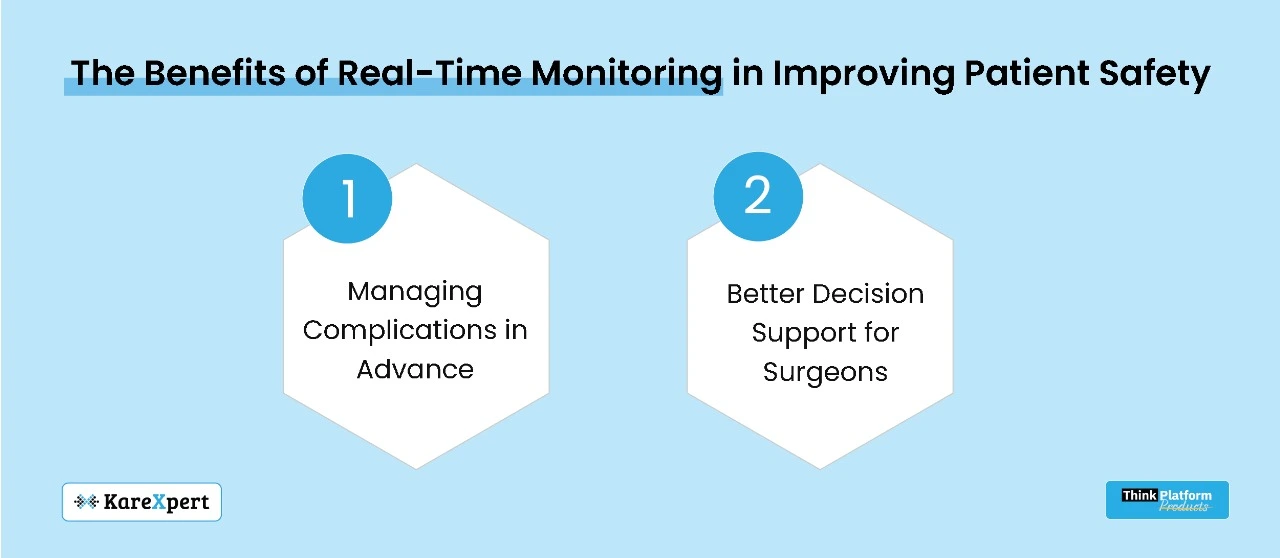OR 2.0: When AI Becomes Your Surgical Co-Pilot

An operating room (OR) is one of the most high-stakes environments in healthcare. Time is crucial, and patient safety is paramount. Even though surgeons are highly skilled, the complexity of performing surgery and the risk of human error inspire the need for an extra layer of security. This is where real-time monitoring systems, such as those offered by Monitra, become indispensable, enhancing patient safety during surgery and leading to better outcomes.
Technological advancements like real-time data analytics, AI alerts, and integrated monitoring systems have changed how surgical teams operate. These tools provide a minute-by-minute view, enabling healthcare providers to make faster decisions, minimizing the chances of complications, and improving overall patient care.
In this blog, we will investigate how real-time OR monitoring makes surgeries safer, predicts unplanned surgical events, and helps prevent adverse outcomes.
1. Real-Time OR Monitoring is Critical
In the OR, real-time monitoring involves continuously tracking a patient’s vital signs, physiological data, and more throughout surgery. These systems use sensors and AI algorithms to capture and analyze data, providing near real-time feedback to the surgical team. Surgeons, anesthesiologists, and nurses can monitor changes in the patient’s condition at a glance and respond quickly when needed.
Surgery is Complicated
Surgical procedures are inherently complex, with many variables that can impact patient safety, whether related to the patient’s pre-existing health or unexpected complications during surgery. Real-time monitoring systems keep an eye on the following critical data points:
Critical Monitoring Parameters:
– Heart rate
– Blood pressure
– Oxygen saturation
– Respiratory rate
– Anesthesia levels
– Blood sugar levels (for diabetic patients)
Real-time data feeds create an early alert system, enabling surgical teams to respond immediately to issues like arrhythmias, oxygen level drops, or adverse reactions to anesthesia—avoiding potentially life-threatening situations.
2. The Benefits of Real-Time Monitoring in Improving Patient Safety

Managing Complications in Advance
One of the most significant benefits of real-time monitoring is its ability to proactively manage complications. Traditionally, healthcare providers respond to complications as they occur. Real-time monitoring allows care to become proactive. Variations in vital signs, such as those signaling internal hemorrhage or drug reactions, can be detected and addressed before they become life-threatening.
AI-powered systems can even anticipate problems based on historical data, warning the surgical team before complications escalate. This is particularly important in complex surgeries or for high-risk patients.
Better Decision Support for Surgeons
Real-time monitoring provides surgeons with a complete database of current patient data, allowing for better decision-making. By integrating data from the patient’s historical medical records, real-time physiological data, and AI-driven insights, surgeons have a more comprehensive picture of the patient’s condition, leading to more accurate, informed decisions during the procedure.
For example, during minimally invasive surgeries, real-time monitoring allows surgeons to “see” the patient’s internal state beyond what is visible on the monitor, helping navigate complex anatomy safely.
3. How AI and Machine Learning Can Eliminate Human Errors
Surgical teams are highly trained, but they are still human. To reduce the risk of human error, real-time monitoring systems with AI and machine learning algorithms act as a backup, providing predictive analytics and automated alerts.
AI-Powered Alerts
AI-powered alerts continuously monitor patient data, comparing it to baseline levels and identifying patterns that may signal complications. These systems automatically notify the surgical team of any concerning changes, such as sudden heart rate shifts or drops in oxygen saturation.
Unlike traditional monitoring systems, AI alerts can predict potential complications before they occur. For example, machine learning algorithms can analyze intraoperative data to predict post-operative issues like infections or blood clots, allowing for preventive care.
4. Enhanced Anesthesia Management
Anesthesia management is a critical aspect of patient safety during surgery. It’s crucial to administer the correct dose to keep the patient asleep and free from pain without compromising their physiological stability. Real-time monitoring systems enable anesthesiologists to continuously track vital signs and anesthesia levels, ensuring precision.
Precise Anesthesia Dosing
Traditionally, anesthesia levels are manually adjusted based on periodic monitoring of vital signs. Real-time monitoring systems, however, collect data continuously, allowing for more precise dosing. Advanced systems can alert anesthesiologists to underdosing or overdosing, reducing the risk of intraoperative awareness and post-operative complications like respiratory distress.
AI tools can further integrate with these systems to automatically adjust anesthesia levels based on patient physiology, increasing the safety and personalization of anesthesia care.
5. Preventing Surgical Site Infections (SSIs)
Surgical Site Infections (SSIs) are a significant concern in the OR, leading to longer recovery times, increased readmission rates, and even higher mortality risks. Real-time monitoring systems track critical metrics like air quality, temperature, and humidity in the OR to help reduce the risk of SSIs.
Sterility and Environmental Monitoring
Advanced real-time monitoring systems can track the sterility of surgical instruments and trigger warnings if re-sterilization is needed mid-surgery. This reduces the risk of contamination and infection, leading to smoother patient recovery.
6. The Future: AI and Robotics Integration in the OR
The future of real-time monitoring in the OR involves even greater integration of AI and robotics. Combining these technologies with real-time data analytics allows for unparalleled precision and control in complex procedures.
AI-Powered Surgical Assistance
AI-driven robotic systems can stabilize surgeons’ movements, improve precision, and provide real-time insights into patient data, helping adjust surgical parameters automatically if necessary. For example, if the system detects a drop in blood pressure, it could automatically adjust surgical instruments to minimize pressure on blood vessels.
Conclusion: Real-Time Monitoring is Crucial for Patient Safety
Real-time monitoring in the OR has evolved from a technological advancement to an essential tool for improving patient safety. From managing complications to improving anesthesia dosing and infection control, these systems ensure optimal and accurate care for patients.
As healthcare continues to advance, real-time monitoring will become even more integral to making surgeries safer and more effective. AI and robotics will play a growing role, enabling surgical teams to work smarter, faster, and more accurately—ultimately improving patient outcomes.
